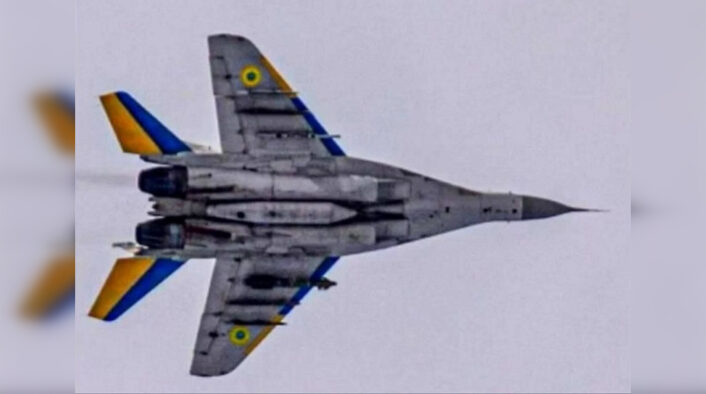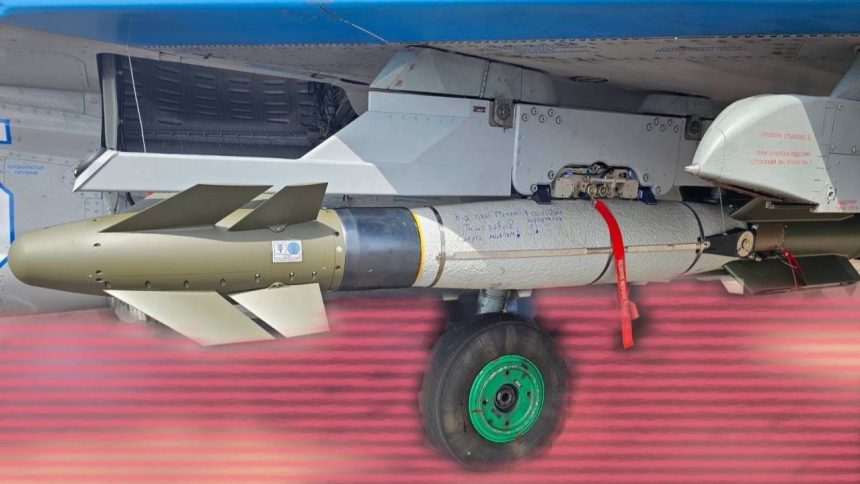Similarly to other weapons, the 250 kg AASM munition is carried by a custom made pylon under the MiG-29’s innermost wing attachment point.
After images and videos earlier this year showed the French-made AASM Hammer guided bomb used by Ukrainian MiG-29s and Su-27s in combat, we now have the first close-up images of the munition on the Fulcrum. The two pictures show the 250 kg bomb installed on a special pylon attached to the innermost hardpoint of the MiG-29’s wing.
This Hammer also has a peculiar texture, which could identify the warhead to which the AASM kit was installed as the BLU-111. The BLU-111A/B was designed by the U.S. Navy, adding to the thermally insensitive explosive filler of the BLU-111B a thermal-protective coating to reduce cook-off chances in fires aboard aircraft carriers.
This warhead is also reportedly used by the French Navy. This could imply that this particular bomb was delivered to Ukraine from the French Navy’s (Marine Nationale) stockpiles, which employs the AASM on the Dassault Rafale Marine.
It’s reasonable to believe that the weapons being delivered are being drafted from both the Air Force’s and Navy’s stocks. French President Emmanuel Macron announced in January 2024 that the country will supply Ukraine with 50 AASM bombs per month and a total of 40 additional SCALP missiles throughout 2024.
French-supplied ASSM-250 Hammer guided aerial bomb installed under the wing of a Ukrainian MiG-29 fighter jet. pic.twitter.com/JXsVblCQOf
— Status-6 (Military & Conflict News) (@Archer83Able) August 8, 2024
The AASM Hammer is also fully compatible with the Mirage 2000, which France pledged to Ukraine, and the F-16. In fact, French officials mentioned in March that the AASM was being integrated on the F-16s before their delivery to Ukraine.
Although the Ukrainian F-16s are currently performing only air defense roles, the bomb is expected to perform better when used by the Viper (as the F-16 is nicknamed by the crews). This is because of its Western avionics, which make the integration and use of the AASM easier compared to the Soviet-era MiG-29 and Su-27.
The photo shows the munition is carried on the left wing of the MiG-29. Similarly to other western weapons such as the JDAM-ER and the SDB, the AASM is using a customized pylon for the carriage under the wing.
On the forward-most point of the pylon there is a GPS antenna, similar to the one of the JDAM pylon. This plus the lack of apertures on the nose cone suggest that the weapon is the inertial and GPS guidance variant, as the MiG-29 lacks laser self-designation capabilities.
AASM Hammer
The AASM (Armement Air-Sol Modulaire “Highly Agile Modular Munition Extended Range”) is a kit, consisting of a nose guidance section and a tail range extension kit, that can be applied to 250 kg and 1000 kg bombs (125 kg and 500 kg variants are under consideration). The kit is offered in three variants: inertial and GPS guidance, GPS, inertial and laser guidance, and SBU-64 GPS, inertial, and infrared guidance.
France had committed to providing 600 AASM bomb kits to Ukraine in 2024, at a rate of 50 per month starting in January. The manufacturer Safran has also increased production capacity to 90 kits per month.
The munition can be employed day or night, under all weather conditions, at stand-off ranges which can reach over 70 km when launched from high altitude. The AASM can also be employed effectively at low altitude (with Safran saying it can still reach stand-off ranges) and highly off-axis respect to the target, and has the ability to perform precision vertical strikes, much like many missiles’ top-down attack capability. It has a solid-fuelled rocket motor in the tail to propel the bomb.

Employment in Ukraine
A video from earlier in April, claimed to have been recorded by a Russian soldier from the ground, showed the bomb diving towards a ground target, leaving behind a horizontal and then vertical contrail. In fact, the AASM Hammer’s rocket motor ignites after being released from the launching aircraft, propelling the bomb in horizontal flight before the final dive towards the target at high speed.
A video that appeared late in June showed a MiG-29 undertaking a “toss bombing” with two Hammers. The jet comes in at a low, near tree-top height (to evade Russian radars) before pulling up in a 45 degree climb, releasing the Hammers at the top of the arc. This zoom climb allows to extend even more the range of the bomb, especially if performed at high altitude.
💥A #Ukrainian Air Force MiG-29 launches AASM-250 ‘Hammer’ guided bombs onto targets within #Russia, near the #Ukraine border.
📍This has been #geolocated to 502030N 0361734E. pic.twitter.com/Uu7fZqqbCF
— WhereisRussiaToday (@WhereisRussia) June 27, 2024
A video which appeared in mid-April showed a Ukrainian Su-27 also dropping the Hammer, this time from higher altitude. The same video shows a Su-27 launching an AGM-88 HARM (High-Speed Anti-Radiation Missile), although it is not clear if the two weapons are being used in conjunction in a SEAD/DEAD (Suppression/Destruction of Enemy Air Defense) tactic, as the video appears to be a montage and thus the weapons might have been employed in separate missions.










